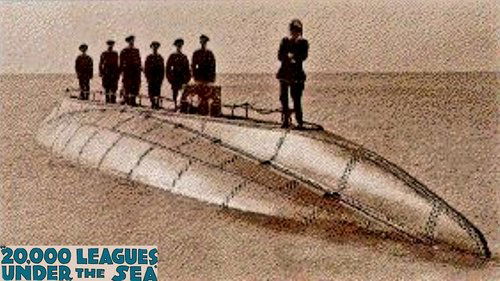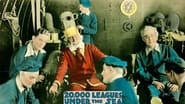Vashirdfel
Simply A Masterpiece
Chirphymium
It's entirely possible that sending the audience out feeling lousy was intentional
Numerootno
A story that's too fascinating to pass by...
Cineanalyst
This screen adaptation of Jules Verne's novel seems to have been timely. Two recent innovations changed the story's relevancy. The film was released in 1916, when German U-Boats were showing the effectiveness of submarines in war, including the sinking of the Lusitania. Verne's science fiction had only recently become more fully realized. Additionally, deep sea travelling was to be exploited by science. Indeed, some of the best sequences in this film are just of fish and sharks in the marine gardens as the characters look through Captain Nemo's magic window. Another invention, the motion-picture underwater photography by the Williamson brothers allowed for Verne's fiction to be more fittingly portrayed with cinema. Certainly, this was a remarkable effect for the art form in 1916, and I think the underwater scenes remain the best parts of this film, with the exception of the cheesy octopus attack.Above water, the plot is plodding and confused. Unfortunately, the filmmakers tried to combine Verne's "Twenty Thousand Leagues Under the Sea" with his sequel to it, "The Mysterious Island". Consequently, through most of the photoplay, there are two parallel narratives loosely and convolutedly connected. Nemo is also transformed into a dark-skinned Muslim and his vengeful mission is changed, and a lengthy and foolish epilogue is added to make sense of the hodgepodge. The science-fiction parts faithful to the title novel are superior to and mix poorly with the added-on exoticism. In addition, the acting is dated. On the other hand, the shots of fish, sharks, the submarine and the diving suits are straightforward and retain interest especially due to the age and precedence.
gzwebdiver-1
I found this film extraordinary, if for no other reason than the fact, that that they used underwater photography showing divers in deep sea helmets using what looked to be rifles with spears attached (early spear guns, I imagine) actually shooting at a large group of sharks swimming around them. I also didn't see any air lines attached to any of these divers, however, if you looked closely, you could see some air bubbles come out of the helmets of the divers every so often. They must have been using some type of compressed air with a regulator, however when I queried Google, I was informed that SCUBA wasn't invented until 1939 for the US Navy and the air regulator hadn't been invented until 1943 by Jacques Cousteau. There was a device that contained compressed air in a belt attached to a diver's helmet that was invented in 1825 but that would only allow a diver to stay under 7 minutes. Were they really able to get all of the shots with the divers within that time frame. Very curious. Does anyone have the technical details for how this film was accomplished? I give this film a 9 for technology and a 5 for story line and acting for a 7 overall.
Snow Leopard
This early adaptation of "20,000 Leagues Under the Sea" is interesting, and generally entertaining, though it lacks the depth of the original story. Its strengths are the underwater effects, the settings, and the camera work, which at times are remarkable for the era. On the other hand, it makes little attempt to convey the most important themes of Verne's story, settling instead for straightforward adventure and melodrama, which are much easier to film.One can only guess how exciting it might have been in 1916 to see some of these images and special effects. Only occasionally does it falter a bit and lose the illusion of reality for a short time; otherwise it is quite convincing. Just seeing the underwater photography alone must have been pretty impressive at the time, and they also managed to get some interesting sea creatures on film. The photography itself is pretty good throughout the movie, and some of the props and settings are nicely done.The story draws rather freely both from "20,000 Leagues ... " and also from another Verne story, "Mysterious Island". It is a mostly entertaining yarn, full of action and with some unexpected developments. But only a small portion of Verne's scientific vision comes across, and none of the depth of the characters and of their interactions has been preserved. Captain Nemo is one of literature's more complex and thought-provoking characters, but here he becomes more of a stock melodrama figure. Professor Arronax and Ned Land are mostly spectators, rather than providing worthy foils for the mad genius Nemo.It's by no means a bad movie, and if you are a silent film fan and/or are interested in film history, there should be enough here to make it worth watching. But otherwise, the 1950's Disney version does a much better job of filming the profound vision and philosophical conflict found in Verne's original novel.
Dutch-20
My first exposure to 20,000 Leagues, was as a kid in the late 50's at the Colony Theatre in Chicago. This was the Walt Disney version.I have since purchased the 1916 silent version. I have to commend the movie-makers for a very well-done attempt at filming such a difficult story. The surface shots of the Nautilus looked very much like the vintage 1900's submarine, "Holland". The interior shots were, of course, stage sets. I have to comment however, on the helm-wheel-- the prop guys forgot to tighten it down!!! Also too, the first (as far as I know) underwater shots were very well done-- remarkable for the times. If anyone at all is familiar with 20,000 Leagues, and has not seen this silent version, by all means, see it--and buy it!!! One last thing--- being an avid theatre organ buff, I only wish the music was tracked in organ-- perhaps by Gaylord Carter or Lee Irwin.Thank you. Your's, Rick







